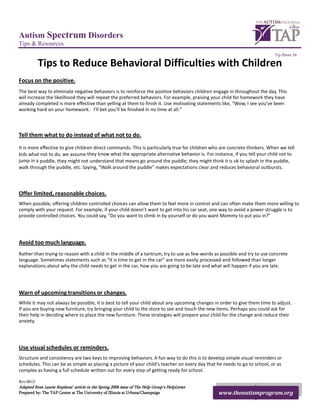
Tips to Reduce Behavioral Difficulties with Children
- 1. Autism Spectrum Disorders Tips & Resources Tip Sheet 24 Tips to Reduce Behavioral Difficulties with Children Focus on the positive. The best way to eliminate negative behaviors is to reinforce the positive behaviors children engage in throughout the day. This will increase the likelihood they will repeat the preferred behaviors. For example, praising your child for homework they have already completed is more effective than yelling at them to finish it. Use motivating statements like, “Wow, I see you’ve been working hard on your homework. Iʼll bet you’ll be finished in no time at all.” Tell them what to do instead of what not to do. It is more effective to give children direct commands. This is particularly true for children who are concrete thinkers. When we tell kids what not to do, we assume they know what the appropriate alternative behavior is. For instance, if you tell your child not to jump in a puddle, they might not understand that means go around the puddle; they might think it is ok to splash in the puddle, walk through the puddle, etc. Saying, “Walk around the puddle” makes expectations clear and reduces behavioral outbursts. Offer limited, reasonable choices. When possible, offering children controlled choices can allow them to feel more in control and can often make them more willing to comply with your request. For example, if your child doesnʼt want to get into his car seat, one way to avoid a power struggle is to provide controlled choices. You could say, “Do you want to climb in by yourself or do you want Mommy to put you in?” Avoid too much language. Rather than trying to reason with a child in the middle of a tantrum, try to use as few words as possible and try to use concrete language. Sometimes statements such as “It is time to get in the car” are more easily processed and followed than longer explanations about why the child needs to get in the car, how you are going to be late and what will happen if you are late. Warn of upcoming transitions or changes. While it may not always be possible, it is best to tell your child about any upcoming changes in order to give them time to adjust. If you are buying new furniture, try bringing your child to the store to see and touch the new items. Perhaps you could ask for their help in deciding where to place the new furniture. These strategies will prepare your child for the change and reduce their anxiety. Use visual schedules or reminders. Structure and consistency are two keys to improving behaviors. A fun way to do this is to develop simple visual reminders or schedules. This can be as simple as placing a picture of your childʼs teacher on every day that he needs to go to school, or as complex as having a full schedule written out for every step of getting ready for school. Rev.0612 Adapted from Laurie Stephensʼ article in the Spring 2006 issue of The Help Groupʼs HelpLetter Prepared by: The TAP Center at The University of Illinois at Urbana/Champaign www.theautismprogram.org
- 2. Autism Spectrum Disorders Tips & Resources Teach calming techniques. Often we tell children to “calm down” when they are upset and feeling anxious. The problem is that we only use the word “calm” when a child is upset! It is important to identify for children what it means to be relaxed or calm so that they know the feeling we want them to experience. Try different relaxation techniques to see which ones work best for your child. For example: counting to ten, taking deep breaths, practicing yoga, listening to music. Stay calm. Remember, the smallest response is usually the best. Acting calm with a minimum of attention will reduce the risk of reinforcing the very behavior you wish to discourage. When you remain calm it also gives you time to think about how you want to respond. Remember, you are modeling desired behavior for your child, the more out of control your child becomes, the more in control you need to appear. When you remain calm, you are teaching your child an appropriate way to handle difficult situations. Rev.0612 Adapted from Laurie Stephensʼ article in the Spring 2006 issue of The Help Groupʼs HelpLetter Prepared by: The TAP Center at The University of Illinois at Urbana/Champaign www.theautismprogram.org
